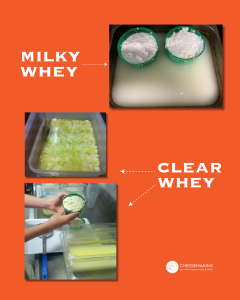Whey should be greenish, yellow and translucent. When your whey is whitish, cloudy or milky it is a sign that something is not quite right in the cheesemaking process. The white is solids that have left the curd and are now in the whey. So your yield will be less than what it could have been. Whey contains about 93% water (milk is about 87% water anyway), less than 1% protein (mostly whey proteins), 1 to 2% fat and about 4% to 5% lactose (carbohydrates). There are also very minute amounts of starter culture, rennet and enzymes in the whey.
 When making cheese, the curd cutting starts the process of curds and whey formation. Whey immediately appears after the cutting step. A large portion of the fat that has risen to the surface of the curd while the milk is still and setting will be lost into the whey. The surfaces of the newly formed curd particles that have just been cut will also lose some fat + protein + lactose into the whey. But at this stage of the cheesemaking process, the whey should be clear. However, you may get a milky or cloudy whey for several reasons.
When making cheese, the curd cutting starts the process of curds and whey formation. Whey immediately appears after the cutting step. A large portion of the fat that has risen to the surface of the curd while the milk is still and setting will be lost into the whey. The surfaces of the newly formed curd particles that have just been cut will also lose some fat + protein + lactose into the whey. But at this stage of the cheesemaking process, the whey should be clear. However, you may get a milky or cloudy whey for several reasons.
Some of the issues that may cause this are:
- Milk composition imbalance: This may affect the proteins in the milk that, later in the process, give structure to the curd and the cheese. Affected proteins cannot provide enough structure to hold all of the remaining milk components eg it may be caused by sick or poorly fed animals, stale milk or excessively pasteurised milk
- The set was not firm enough at cutting: This causes the curd to break or fracture in the later cheesemaking steps, especially the stir step. Caused by old rennet, not enough rennet, cutting too early, temperature not warm enough, not enough starter culture
- Breaking the curd while stirring: Curd needs to be stirred very slowly and gently after cutting. A ‘healing’ process starts as soon as the curds have been cut, and healing progresses and the curd develops its own rind or casing around its outside. The casing (along with the proteins) holds all of the milk components into each single piece of curd. As the casing hardens/firms, the curds can be gradually stirred at a faster rate.
- Aggressive hooping of the curd. This is especially important for soft cheese, where the curd particle is more easily broken due to the higher moisture content and usually the larger size of the curd particle.



